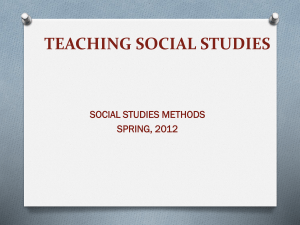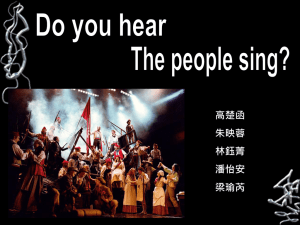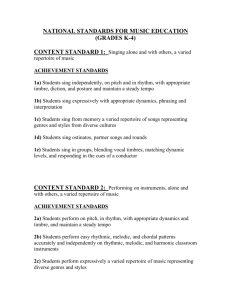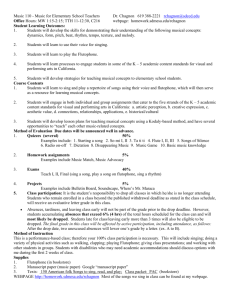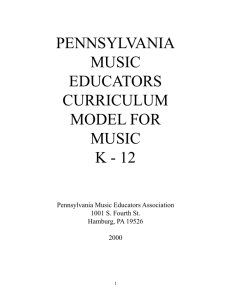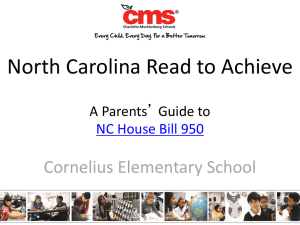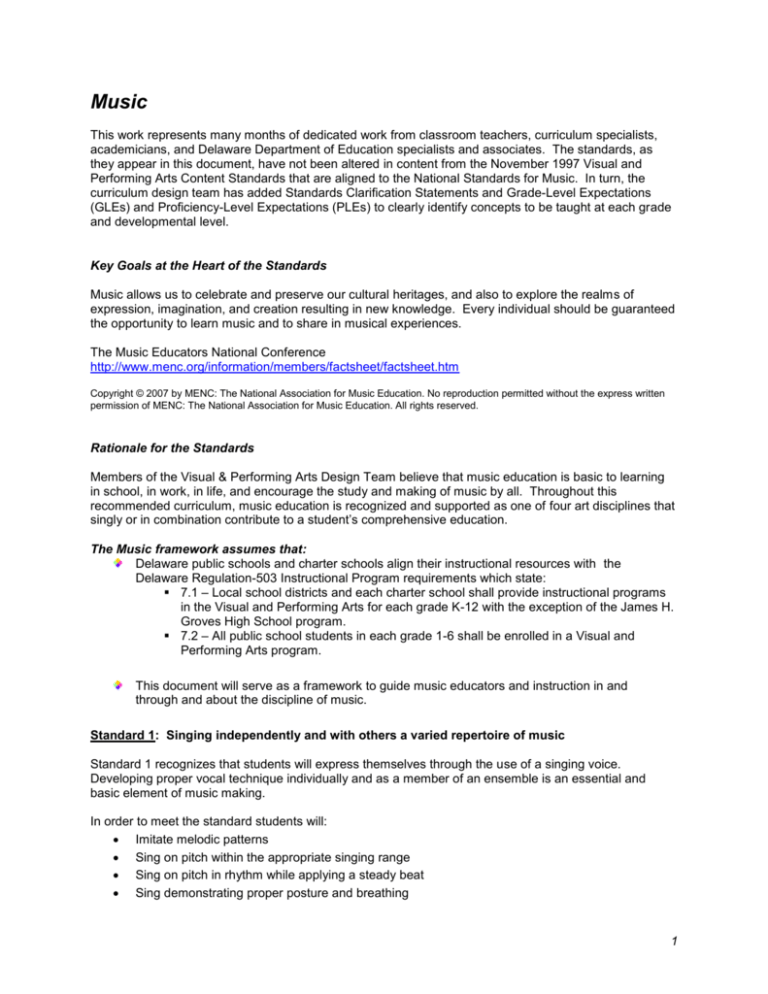
Music
This work represents many months of dedicated work from classroom teachers, curriculum specialists,
academicians, and Delaware Department of Education specialists and associates. The standards, as
they appear in this document, have not been altered in content from the November 1997 Visual and
Performing Arts Content Standards that are aligned to the National Standards for Music. In turn, the
curriculum design team has added Standards Clarification Statements and Grade-Level Expectations
(GLEs) and Proficiency-Level Expectations (PLEs) to clearly identify concepts to be taught at each grade
and developmental level.
Key Goals at the Heart of the Standards
Music allows us to celebrate and preserve our cultural heritages, and also to explore the realms of
expression, imagination, and creation resulting in new knowledge. Every individual should be guaranteed
the opportunity to learn music and to share in musical experiences.
The Music Educators National Conference
http://www.menc.org/information/members/factsheet/factsheet.htm
Copyright © 2007 by MENC: The National Association for Music Education. No reproduction permitted without the express written
permission of MENC: The National Association for Music Education. All rights reserved.
Rationale for the Standards
Members of the Visual & Performing Arts Design Team believe that music education is basic to learning
in school, in work, in life, and encourage the study and making of music by all. Throughout this
recommended curriculum, music education is recognized and supported as one of four art disciplines that
singly or in combination contribute to a student’s comprehensive education.
The Music framework assumes that:
Delaware public schools and charter schools align their instructional resources with the
Delaware Regulation-503 Instructional Program requirements which state:
7.1 – Local school districts and each charter school shall provide instructional programs
in the Visual and Performing Arts for each grade K-12 with the exception of the James H.
Groves High School program.
7.2 – All public school students in each grade 1-6 shall be enrolled in a Visual and
Performing Arts program.
This document will serve as a framework to guide music educators and instruction in and
through and about the discipline of music.
Standard 1: Singing independently and with others a varied repertoire of music
Standard 1 recognizes that students will express themselves through the use of a singing voice.
Developing proper vocal technique individually and as a member of an ensemble is an essential and
basic element of music making.
In order to meet the standard students will:
Imitate melodic patterns
Sing on pitch within the appropriate singing range
Sing on pitch in rhythm while applying a steady beat
Sing demonstrating proper posture and breathing
1
Sing demonstrating proper vocal technique
Sing expressively utilizing dynamics and phrasing
Sing call and response
Sing ostinati with songs
Sing in groups in response to gestures of a conductor
Sing rounds
Sing partner songs
Sing music in 2 and 3 parts
Sing in groups and blending vocal timbres
Sing a repertoire of songs representing different genres, styles, and languages
Sing expressively with phrasing, dynamics, and stylistic interpretation
Sing music in 4 parts with and without accompaniment
Sing a repertoire of choral literature with expression and technical accuracy, including songs
performed from memory
As a result, teachers at all levels will incorporate vocalization into all aspects of the music curriculum.
Following instruction by certified music educators, students should be able to achieve proficiency at
grade-level and at proficiency levels of expectation.
Standard 2: Performing on instruments, independently and with others, a varied repertoire of
music
Standard 2 recognizes that students will express themselves through the use of an instrument.
Developing proper instrumental technique individually and as a member of an ensemble is an essential
and basic element of music making.
In order to meet the standard, students will:
Imitate rhythmic and melodic patterns on pitched and unpitched instruments
Perform on pitched and unpitched instruments in rhythm while applying a steady beat
Perform rhythm accompaniments by ear
Perform tonal accompaniments by ear
Perform melodies by ear using a melodic instrument
Perform with proper posture and breathing
Perform with proper instrumental technique
Perform in groups in response to gestures of a conductor
Perform an independent part in an ensemble setting
Perform music representing diverse genres and styles
Perform in groups with blend and balance
Perform expressively with phrasing, dynamics, and stylistic interpretation
Perform a repertoire of instrumental literature with expression and technical accuracy on a
pitched or unpitched instrument
As a result, teachers at all levels will incorporate instrumental education into all aspects of the music
curriculum. Following instruction by certified music educators, students should be able to achieve
proficiency at grade-level and at proficiency levels of expectation.
2
Standard 3: Improvising melodies, variations, and accompaniments
Standard 3 recognizes that a major component of the creative process involves the freedom that comes
with improvisation. Developing those skills that are necessary to improvise will permit students to express
themselves in multiple ways through various genres.
In order to meet the standard, students will:
Improvise rhythmically with voice or on instrument
Improvise ostinato accompaniments
Improvise unaccompanied melodies
Improvise melodic embellishments on given melodies in various tonalities
Improvise rhythmic variations on given melodies
Improvise melodic variations
Improvise melodies over basic chord progressions
Improvise melodies over given rhythm and tonal context
Improvise basic harmonic accompaniment or bass line to a given melody
Improvise melodies over given rhythm and harmonic context consistent to the styles
As a result, teachers at all levels will incorporate instruction in improvisation into all aspects of the music
curriculum. Following instruction by certified music educators, students should be able to achieve
proficiency at grade-level and at proficiency levels of expectation.
Standard 4: Composing and arranging music within specific guidelines
Standard 4 recognizes that a major aspect of the creative process involves the freedom that comes with
composing and arranging. Developing those skills that are necessary to compose and arrange will permit
students to express themselves and develop notational as well as aural skills in multiple ways through
various genres.
In order to meet the standard, students will:
Compose short songs and instrumental pieces
Arrange short songs and/or instrumental pieces
Utilize standard written notation in composition of short songs
Utilize compositional technology
Manipulate a variety of traditional, nontraditional, and electronically produced sounds while
creating or arranging
Organize the elements of music into compositions which are unified and varied
As a result, teachers at all levels will incorporate instruction in composition and arranging into all aspects
of the music curriculum. Following instruction by certified music educators, students should be able to
achieve proficiency at grade-level and at proficiency levels of expectation.
Standard 5: Reading and notating music
Standard 5 recognizes that a major part of the creative process involves the understanding and use of
notation. Developing the skills that are necessary to read and notate music will permit students to
express themselves in multiple ways.
In order to meet the standard, students will:
Identify and define standard notation symbols
Read rhythmic notation
3
Read melodic notation
Read a single line of an instrumental or vocal part
Notate symbols and terms for meter and rhythm
Notate symbols for pitch
Notate symbols and terms referring to dynamics, tempo, and articulation
Read an instrumental or vocal score
Read unfamiliar music with tonal and rhythmic accuracy
Read simple melodies in 2 or more clefs
As a result, teachers at all levels will incorporate instruction in reading and notating music into all aspects
of the music curriculum. Following instruction by certified music educators, students should be able to
achieve proficiency at grade-level and at proficiency levels of expectation.
Standard 6: Listening to, describing, and analyzing music and music performances
Standard 6 recognizes that a major part of the process of understanding music is through the process of
listening, describing, and analyzing music and musical performances. Developing the skills that are
necessary require effort and understanding that will permit students to express themselves in ways
having listened to, described, and analyzed multiple forms of music.
In order to meet the standard, students will:
Express changes and contrasts in music through movement
Identify and classify instruments according to family
Identify and classify voices by range and quality
Identify and describe basic music forms
Identify and describe common instrumental and vocal ensembles
Express through verbal and nonverbal means various styles/genres of music
Identify the elements of music within a musical composition
Analyze form including theme and variation, basic binary, tertiary and rondo forms, and more
complex forms
Identify and explain compositional devices and techniques used in a musical work
As a result, teachers at all levels will incorporate instruction in listening, describing, and analyzing music
and music performance into all aspects of the music curriculum. Following instruction by certified music
educators, students should be able to achieve proficiency at grade-level and at proficiency levels of
expectation.
Standard 7: Evaluating music and music performances
Standard 7 recognizes that a major part of the process of understanding music is through the process of
evaluating music and musical performances. Developing those skills requires instruction that will permit
students to understand and express themselves in many ways.
In order to meet the standard, students will:
Express personal preferences for specific musical styles
Identify ways for evaluating compositions and performances
Explain personal music preferences using appropriate terminology
Discuss and evaluate the relationship between music and human emotions
Develop and apply criteria for evaluating compositions and performances
Develop criteria for evaluating the quality and effectiveness of music performances and
compositions and apply the criteria in their personal listening and performing
4
Critically evaluate one's own musical creations
Critically evaluate the compositions, arrangements, and improvisations of others by applying
specific criteria appropriate for the style of the music and offer constructive suggestions for
improvement
As a result, teachers at all levels will incorporate instruction in evaluating music and musical
performances into all aspects of the music curriculum. Following instruction by certified music educators,
students should be able to achieve proficiency at grade-level and at proficiency levels of expectation.
Standard 8: Making connections between music, the other arts, and other curricular areas
Standard 8 recognizes the importance of making connections between music, arts, and the other
curricular areas. Making these connections not only builds bridges of understanding but provides a basis
from which logical connections can be made and further emphasis can be placed on the commonalities
across all the arts disciplines. Developing the skills that are necessary require effort and understanding
that will permit students to understand and express themselves in many ways.
In order to meet the standard, students will:
Identify, compare, and contrast the roles of creators, performers, and consumers in the
production and presentation of the arts including music
Make connections with other disciplines as they relate to music
Illustrate ways in which the principles and subject matter of other curricular areas are interrelated
to music
Compare and contrast terms common between the arts and other curricular areas (e.g., texture,
color, form)
Compare and contrast artistic themes across cultures, history, and multiple media
As a result, teachers at all levels will incorporate cross-curricular understanding and connections to other
areas. Following instruction by certified music educators, students should be able to achieve proficiency
at grade-level and at proficiency levels of expectation.
Standard 9: Understanding music in relation to diverse cultures, times, and places
Standard 9 recognizes the importance of making connections and relationships to diverse cultures, times,
and places. Making these connections not only builds bridges of understanding but provides a basis from
which logical connections can be made and further emphasis can be placed on the commonalities across
all cultures and throughout history.
In order to meet the standard, students will:
Identify and describe the roles of musicians in various historical periods, cultures, genre, and
styles
Listen to music from various periods and diverse cultures by genre or style
Describe how elements of music are used in various historical periods, cultures, genres, and
styles
Identify sources of American music genres; trace the evolution of those genres and well-known
musicians associated with them
Classify and describe distinguishing characteristics of representative music genres and styles
from various cultures and historical periods
Identify and explain the characteristics that cause a musical work to be considered culturally,
historically, and/or geographically significant
5
As a result, teachers at all levels will incorporate cultural and historic connections to other areas through
music. Following instruction by certified music educators, students should be able to achieve proficiency
at grade-level and at proficiency levels of expectation.
Adapted with permission from National Standards for Arts Education. Copyright © 1994 by Music
Educators National Conference (MENC). Used by permission.
6

